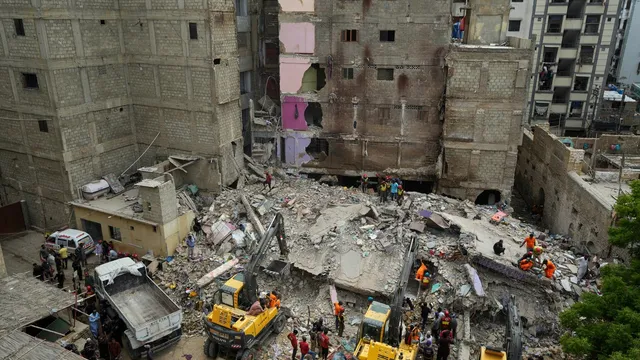
Collapsed building in Karachi kills 16 amid warnings of unsafe conditions
2025-07-07 03:23- Rescue operations continue as teams search for survivors, retrieving additional bodies.
- Residents were warned about the building's unsafe conditions, but many did not evacuate.
- The frequent occurrence of building collapses in Pakistan raises urgent concerns for public safety.
Express your sentiment!
Insights
In Pakistan, specifically in Karachi, a tragic incident occurred recently when a multistory residential building collapsed, resulting in at least 16 fatalities. The building, which had been deemed unsafe, was home to approximately 40 families. Rescue operations began promptly as emergency teams worked tirelessly to recover trapped residents from the debris. Despite the harsh weather conditions, rescue workers used heavy machinery to search for survivors, with reports indicating that at least eight individuals remained trapped under the rubble. Relatives of those missing expressed their anguish and helplessness during the rescue efforts, holding onto hope for their loved ones' safe return. Authorities revealed that eviction notices indicating the building's unsafe status had been issued over the past few years, but many residents and landlords claimed they had not received these warnings. Government officials reported that structural issues, such as visible cracks, had prompted warnings for occupants. Unfortunately, these cautions were largely ignored, leading to this catastrophic event. This collapse unearths a recurring issue in Pakistan where building collapses occur frequently, predominantly due to the use of substandard construction materials and negligence in enforcing safety regulations. Fatalities and injuries due to similar incidents have raised concerns about public safety in such structures. The aftermath has seen rescue teams continuing their operations, retrieving additional bodies and aiding survivors. Eyewitness accounts from the local residents cite the presence of nearly a hundred people within the building during the collapse. Some individuals had left prior to the incident, receiving frantic warnings from family members. Local authorities faced criticism for their failure to enforce proper building codes and safety measures, which has contributed to the high incidence of such collapses in this densely populated area. As the situation evolved, the local government urged for more thorough inspections of unsafe buildings in the region to prevent future tragedies. Public pressure is mounting, highlighting the desperate need for improved construction practices and stronger adherence to safety regulations. While the rescue operations are ongoing, the emotional impact on the families affected is profound, leaving many to mourn their loved ones and consider the precarious living conditions that existed in their community.
Contexts
Building safety regulations in Pakistan are critical in ensuring the safety and well-being of the populace, particularly in urban areas where rapid development has outpaced effective regulatory measures. The country's legislative framework addresses these concerns through various laws and regulations aimed at establishing standards for construction practices, maintenance, and overall building safety. Key regulations encompass the Pakistan Building Code, which outlines the technical specifications required for construction, along with local building authority requirements enforced at the municipal level. These regulations aim to minimize risks associated with structural failures, fire hazards, and natural disasters, thereby safeguarding buildings and their occupants. Despite the presence of these regulations, enforcement remains a significant challenge. In many regions, particularly in densely populated urban centers, compliance is often overlooked due to factors such as corruption, lack of awareness, and the informal nature of many construction practices. As a result, numerous buildings do not adhere to established safety codes, leading to tragic incidents, including building collapses and fires. Raising awareness among builders and contractors about compliance and the importance of safety standards is essential for improving overall building safety and reducing risks. Furthermore, strengthening enforcement mechanisms can promote adherence to building codes and penalties for non-compliance. The role of local governments is pivotal in ensuring that building safety regulations are implemented effectively. City administrations and local building authorities must enhance their capacity to monitor construction activities, conduct inspections, and enforce compliance with safety regulations. Collaboration with civil society organizations, professional bodies, and civil engineers can facilitate training programs and awareness campaigns, educating stakeholders about the importance of adhering to building safety norms. Moreover, technology can be leveraged, such as the use of digital platforms for inspections, reporting violations, and tracking compliance more efficiently, thus improving accountability. In summary, building safety regulations in Pakistan are vital to ensure the structural integrity and safety of constructions amidst rapid urbanization. Although legislative frameworks exist, the real challenge lies in proper enforcement and adherence to established codes. By focusing on education, increasing local government capabilities, and utilizing modern technology, Pakistan can enhance the safety of its buildings, ultimately protecting its citizens and reducing the risks associated with inadequate construction practices. The pathway to effective building safety regulation requires a multi-faceted approach, combining regulation, enforcement, and community involvement to foster a culture of safety in construction.